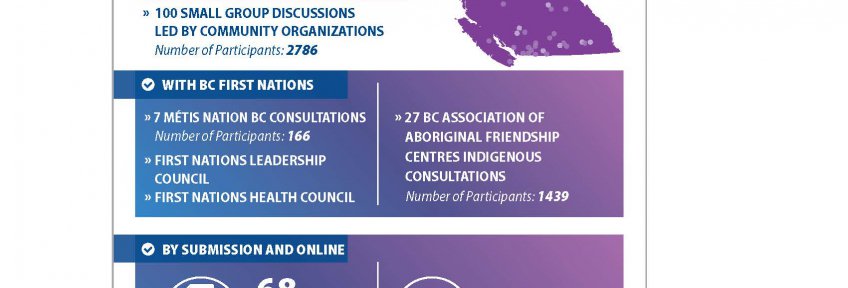In 2016, British Columbia (B.C.) had the second highest poverty rate in Canada but was the only province without a poverty reduction strategy. To inform its first strategy, a new government completed the most extensive poverty engagement to date in Canada, focusing on people with lived experience of poverty.
To address barriers, B.C. used a range of innovative engagement approaches including direct supports for participants, dedicated Indigenous engagement and funding grants to non-profits.
Innovation Summary
Innovation Overview
B.C. has had one of the highest poverty rates in Canada for decades and the second highest poverty rate in Canada in 2016, with 12% of the population living in poverty in 2016 according to Canada’s Official Poverty Line. This represents 557,000 people including 99,000 children.
Despite these rates, BC was the only province in Canada that had not developed a poverty reduction strategy. This started to change in 2017 with the election of a new government with a key commitment to develop a strategy with legislated targets and timelines.
To inform B.C.’s first poverty reduction strategy, an extensive engagement took place from October 2017-March 2018. The goal was to ensure that government heard from diverse populations throughout the province, with a particular focus on people living in poverty who had never been consulted on the issues facing them or what solutions are needed.
Government recognized that people in poverty have significant socio-economic barriers to participating in traditional engagement processes. These include geographic barriers, with people living in rural and remote communities; financial barriers, such as the cost to purchase a bus ticket or food costs when away from home; physical barriers, such as mobility issues; and social barriers, as people can feel stigmatized or discriminated against in their communities for being poor. The goal of the engagement was to address these barriers to the greatest extent possible to ensure that the strategy was informed by those most affected by poverty.
B.C. undertook a range of innovative approaches to achieve this goal. Government appointed an external advisory forum on poverty reduction, which included people with lived experience of poverty. This Forum co-designed the engagement, and their feedback influenced major elements, including changing complex questions originally posed to simply: “what issues are facing you and/or people living in poverty in your community?”; and, “what solutions could help make a difference?”
The Province hosted 28 community meetings, all attended by Cabinet members. Key innovative approaches of the meetings included:
• Community outreach to homeless shelters and non-profit organizations to encourage attendance
• A warm meal at each meeting, along with containers for leftovers
• A $20 participation stipend for participants who self-identified as living in poverty
• Community facilitators who supported the conversations, making sure everyone’s voice was heard
• On-site mental health and harm reduction support workers
• Secure storage for people who were homeless’ belongings
• Other accommodations to support participation including bus tickets, taxi fares, and child care
While in communities, Cabinet members met with local government representatives, business and community leaders.
The Forum also recommended government provide grants to non-profit organizations to support 100 small group discussions with groups facing poverty-related barriers or who lived in rural and remote communities. This was an overwhelming success with a 100 percent feedback return rate.
To respect B.C.’s commitment to reconciliation with Indigenous Peoples, B.C. collaborated with Indigenous organizations to create a dedicated Indigenous engagement process. In discussions, Indigenous leaders advised that engagement in their communities should be self-determined. To meet this request, funding was provided directly to three Indigenous organizations in B.C. to host their own community meetings and provide feedback in a format that worked best for their community. The Indigenous engagement process included meetings with First Nations leadership organizations in B.C., grants for community meetings in rural and remote Indigenous communities, and separate Indigenous (First Nations and Metis) consultations.
Other more traditional engagement processes were also in place, such as an engagement website for feedback and a voicemail system. In total, over 8,500 people participated, with 60 percent of people self-identifying as having lived experience of poverty. An overview of the engagement is captured in a public consultation report, “What We Heard about Poverty in B.C.”
The B.C. government greatly benefited from the engagement. In November 2018, the B.C. Legislature unanimously passed the Poverty Reduction Strategy Act, which includes a goal to reduce the poverty rate by 25 percent for all people in poverty and 50 percent for children by 2024. The strategy, TogetherBC, was released on March 18, 2019, and outlines a cross-government approach to achieving the targets. The Act also commits government to engage people with lived experience of poverty in the implementation of the strategy through an Advisory Committee, and to hold an engagement each time the strategy is reviewed/updated, at least every 5 years, so it continues to be informed by the experiences of people in poverty, regardless of the government of the day.
Innovation Description
What Makes Your Project Innovative?
This project was innovative because of the extensive engagement focused on the voices of people in poverty. By enabling multiple engagement streams, learning from the community, and adapting strategies, B.C.’s engagement became the most extensive poverty consultation to date in Canada, according to national advocacy groups. This leadership is also recognized by other Canadian provinces who have reached out to B.C. to inform their own public engagements.
There have also been requests from within the B.C. government to inform future provincial engagements. Most approaches had never been tried before including providing extensive supports at community meetings, appointing people with lived experience of poverty to Minister advisory committees and providing funding to Indigenous communities and non-profit organizations to self-convene. The dedicated Indigenous engagement is of particular interest, as B.C. works to implement its commitment to reconciliation with Indigenous Peoples.
What is the current status of your innovation?
The status of the innovation depends on the focus. The focus of this submission is the engagement process leading up to the strategy which concluded in March 2018. Other areas of the B.C. government and other jurisdictions in Canada are currently learning from this innovation and applying it to their work.
TogetherBC, was released on March 18, 2019, and is currently in implementation. Built on the principles of Affordability, Opportunity, Reconciliation, and Social Inclusion, the strategy focuses on six priority areas:
• Affordable housing
• Supporting families, children and youth
• Expanding access to education and training
• More opportunities, more jobs
• Improving income supports
• Investing in social inclusion
The B.C. government will invest approximately $4 billion over the next three years to support the strategy including housing and childcare investments, a new Child Opportunity Benefit, income and disability assistance rate increases, and minimum wage increases.
Innovation Development
Collaborations & Partnerships
There were many collaborations and partnerships that led to the innovative engagement process. Key collaborators included the Minister’s Advisory Forum on Poverty Reduction which brought together poverty advocates and experts as well as people living in poverty to provide advice and guidance on the engagement process. Indigenous organizations were also key collaborators: the First Nations Leadership Council, Metis Nation B.C, and the B.C. Association of Aboriginal Friendship Centres.
Users, Stakeholders & Beneficiaries
The B.C. government was a key beneficiary of the innovation, learning from first-hand experiences of people in poverty in communities across B.C. People in poverty, including children, will also benefit as policies are developed to help break the cycle of poverty in B.C. Many participants stated that this was the first time they were directly asked what issues they and their communities are facing and what solutions could make a difference.
Innovation Reflections
Results, Outcomes & Impacts
The poverty reduction engagement supported and led to significant contributions to support B.C.’s goal to reduce the poverty rate by 25 percent for all persons living in poverty and 50 percent for children by 2024. As outlined in TogetherBC: B.C.’s First Poverty Reduction Strategy, B.C. has increased income and disability assistance rates by $1,800 per year, made historic investments in housing and child care, cut Medical Services Plan premiums by 50% with a commitment to fully eliminate by 2021, increased the minimum wage with a commitment to raise the minimum wage to $15.20 by 2021, eliminated interest on B.C. student loans, implemented a revenue-sharing agreement for First Nations communities, and announced a new Child Opportunity Benefit starting in October 2020, to provide families with financial relief.
Challenges and Failures
Each phase of the engagement had challenges, but its iterative nature made it possible to address them. Outreach to target populations was a challenge when planning community meetings, given the multiple barriers participants face. In response, organizers went to homeless shelters and other organizations upon arrival in communities to spread the word. After some participants had a difficult time sharing their stories at the first meeting, mental health supports were provided at subsequent meetings.
Despite best efforts, it remained challenging to reach diverse populations. Realizing many groups could not attend meetings due to poverty-related barriers, on the advice of the Minister’s Forum, B.C. government offered 100 grants for non-profits to convene their own sessions with vulnerable groups: seniors, the working poor, single mothers, LGBTQ2S+, people who are homeless, among others. Similarly, B.C. government offered funding for meetings in remote First Nations villages.
Conditions for Success
Several factors led to success. Government leadership was a key factor, with the Minister and Parliamentary Secretary responsible for poverty reduction showing a strong presence, meeting with leaders and hosting community roundtables alongside attending community meetings. Throughout the engagement, the Minister also shared his own experiences growing up in poverty (see linked video). This enabled him to connect with participants and reinforced the message that government was listening to people’s concerns and was going to take action.
Collaboration with Indigenous leaders during the development of the engagement and government’s willingness to provide autonomy to Indigenous communities to host their own poverty reduction community meetings was also a key condition for success. The engagement was also sufficiently resourced, including a budget to provide participant stipends and a range of supports, in recognition that people in poverty have additional barriers to participate.
Replication
The success of the engagement led to a legislative commitment in the Poverty Reduction Strategy Act to consult with key groups of vulnerable populations each time the strategy is updated (at least every five years) and to ensure the consultations are undertaken in a manner that fulfils B.C.’s commitment to reconciliation with Indigenous Peoples. The Act also requires the minister to establish an ongoing Advisory Committee, that includes people with lived experience, to advise the minister on matters relating to poverty and prevention.
The feedback received during the engagement process significantly influenced B.C.’s first poverty reduction strategy, TogetherBC, including the principles, action areas and investments. The engagement results will continue to inform future poverty reduction efforts, which will be outlined in annual public reports (another legislative requirement).
Lessons Learned
The B.C. government’s multi-faceted engagement strategy allowed B.C. to capture the many voices of people in poverty. People’s experiences of poverty are personal, and it’s critical to listen and learn from these experiences to better understand the complex issues that can create a cycle of poverty.
The success of this engagement would not have been possible without flexibility and adaptation. Listening and responding to the feedback and guidance from key collaborators, partners, and participants, specifically people with lived experience of poverty, was key to the success of the project.
Many changes were made along the way. Rather than providing an extensive discussion guide to participants that shared policy-driven questions, B.C. simplified the questions posed in the engagement to two-parts:
1. What issues are facing you and/or people living in poverty in your community?
2. What solutions could help make a difference?
These simple questions were innovative in themselves, as they did not lead people to answer in a certain way. Instead, they were able to share their personal experiences and discuss the broad circumstances that lead people into poverty and continue the cycle. Participants, particularly those in Indigenous communities, said this was the first time the B.C. government had ever asked them these questions.
Supporting Videos
https://www2.gov.bc.ca/gov/content/governments/about-the-bc-government/poverty-reduction-strategy
Status:
- Implementation - making the innovation happen
- Diffusing Lessons - using what was learnt to inform other projects and understanding how the innovation can be applied in other ways
Date Published:
18 April 2019


